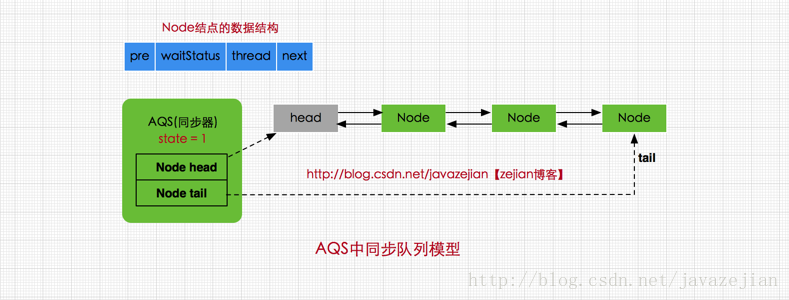AQS是很多ReentranLock,CountdownLatch,Semaphore等基类,弄清楚AQS对锁和多线程的理解其实很重要。AQS的主要使用主要数据结构是CLH队列。
static final class Node {
//共享节点
static final Node SHARED = new Node();
//独占
static final Node EXCLUSIVE = null;
/**
* 因为超时或者中断,节点会被设置为取消状态,被取消的节点时不会参与到竞争中的,他会一直保持取消状态不会转变为其他状态;
*/
static final int CANCELLED = 1;
/**
* 后继节点的线程处于等待状态,而当前节点的线程如果释放了同步状态或者被取消,将会通知后继节点,使后继节点的线程得以运行
*/
static final int SIGNAL = -1;
/**
* 节点在等待队列中,节点线程等待在Condition上,当其他线程对Condition调用了signal()后,改节点将会从等待队列中转移到同步队列中,加入到同步状态的获取中
*/
static final int CONDITION = -2;
/**
* 表示下一次共享式同步状态获取将会无条件地传播下去
*/
static final int PROPAGATE = -3;
//等待状态
volatile int waitStatus;
//前驱结点
volatile Node prev;
//后驱节点
Node nextWaiter;
final boolean isShared() {
return nextWaiter == SHARED;
}
final Node predecessor() throws NullPointerException {
Node p = prev;
if (p == null)
throw new NullPointerException();
else
return p;
}
Node() { // Used to establish initial head or SHARED marker
}
Node(Thread thread, Node mode) { // Used by addWaiter
this.nextWaiter = mode;
this.thread = thread;
}
Node(Thread thread, int waitStatus) { // Used by Condition
this.waitStatus = waitStatus;
this.thread = thread;
}
}
AQS其实就关键的几个变量
//指向同步队列队头
private transient volatile Node head;
//指向同步的队尾
private transient volatile Node tail;
//同步状态,0代表锁未被占用,>=1代表锁已被占用
private volatile int state;
其实就是双向的队列
再来看看入队列:
private Node addWaiter(Node mode) {
Node node = new Node(Thread.currentThread(), mode);
// Try the fast path of enq; backup to full enq on failure
Node pred = tail;
if (pred != null) {
node.prev = pred;
if (compareAndSetTail(pred, node)) {
pred.next = node;
return node;
}
}
enq(node);
return node;
}
尝试快速地往队列中添加节点,如果添加失败那么会走入的enq
private Node enq(final Node node) {
for (;;) {
Node t = tail;
if (t == null) { // Must initialize
if (compareAndSetHead(new Node()))
tail = head;
} else {
node.prev = t;
if (compareAndSetTail(t, node)) {
t.next = node;
return t;
}
}
}
}
可以看到上边两个方法都用了CAS来保证的数据的添加的高效。而且AQS是通过死循环来添加末尾节点的,只有添加成功才会返回。
出队
CLH出队列的时候也是遵循的FIFO的。首节点的线程释放同步状态后,将会唤醒它的后继节点(next),而后继节点将会在获取同步状态成功时将自己设置为首节点,这个过程非常简单,head执行该节点并断开原首节点的next和当前节点的prev即可,注意在这个过程是不需要使用CAS来保证的,因为只有一个线程能够成功获取到同步状态。
获取同步状态
public final void acquire(int arg) {
if (!tryAcquire(arg) &&
acquireQueued(addWaiter(Node.EXCLUSIVE), arg))
selfInterrupt();
}
tryAcquire:去尝试获取锁,获取成功则设置锁状态并返回true,否则返回false。该方法自定义同步组件自己实现,该方法必须要保证线程安全的获取同步状态。
addWaiter:如果tryAcquire返回FALSE(获取同步状态失败),则调用该方法将当前线程加入到CLH同步队列尾部。
acquireQueued:当前线程会根据公平性原则来进行阻塞等待(自旋),直到获取锁为止;并且返回当前线程在等待过程中有没有中断过。
selfInterrupt:产生一个中断。
acquireQueued方法为一个自旋的过程,也就是说当前线程(Node)进入同步队列后,就会进入一个自旋的过程,每个节点都会自省地观察,当条件满足,获取到同步状态后,就可以从这个自旋过程中退出,否则会一直执行下去。如下:
final boolean acquireQueued(final Node node, int arg) {
boolean failed = true;
try {
//中断标志
boolean interrupted = false;
/*
* 自旋过程,其实就是一个死循环而已
*/
for (;;) {
//当前线程的前驱节点
final Node p = node.predecessor();
//当前线程的前驱节点是头结点,且同步状态成功
if (p == head && tryAcquire(arg)) {
setHead(node);
p.next = null; // help GC
failed = false;
return interrupted;
}
//获取失败,线程等待--具体后面介绍
if (shouldParkAfterFailedAcquire(p, node) &&
parkAndCheckInterrupt())
interrupted = true;
}
} finally {
if (failed)
cancelAcquire(node);
}
}
本文由 妖言君 创作,采用 知识共享署名4.0 国际许可协议进行许可
本站文章除注明转载/出处外,均为本站原创或翻译,转载前请务必署名
最后编辑时间为: Jan 10, 2021 at 03:05 pm
